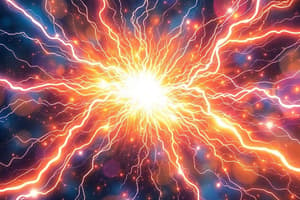Podcast
Questions and Answers
What is the direction of the electrostatic force between two point charges with opposite signs?
What is the direction of the electrostatic force between two point charges with opposite signs?
- Parallel to the direction of the charges
- Attractive (correct)
- Perpendicular to the direction of the charges
- Repulsive
What is the value of Coulomb's constant in SI units?
What is the value of Coulomb's constant in SI units?
- 8.99 x 10^11 N m^2 C^2
- 8.99 x 10^10 N m^2 C^2
- 8.99 x 10^8 N m^2 C^2
- 8.99 x 10^9 N m^2 C^2 (correct)
What is the significance of the charge conservation principle?
What is the significance of the charge conservation principle?
- Charge can be created or destroyed
- Charge can be transferred from one object to another
- The total electric charge in a closed system can change over time
- The total electric charge in a closed system remains constant over time (correct)
What is the mathematical representation of the charge conservation principle?
What is the mathematical representation of the charge conservation principle?
What is the effect of increasing the distance between two point charges on the electrostatic force between them?
What is the effect of increasing the distance between two point charges on the electrostatic force between them?
What is the direction of the electrostatic force between two point charges with the same sign?
What is the direction of the electrostatic force between two point charges with the same sign?
Flashcards are hidden until you start studying
Study Notes
Electric Charge
Coulomb's Law
- Describes the electrostatic force between two point charges
- Mathematically represented as: F = k * (q1 * q2) / r^2
- Where:
- F is the electrostatic force between the two charges
- k is Coulomb's constant (approximately 8.99 x 10^9 N m^2 C^2)
- q1 and q2 are the magnitudes of the two point charges
- r is the distance between the centers of the two charges
- The force is:
- Attractive if the charges are opposite in sign
- Repulsive if the charges are the same sign
Charge Conservation
- The total electric charge in a closed system remains constant over time
- Charge cannot be created or destroyed, only transferred from one object to another
- Mathematically represented as: ΔQ = Q_final - Q_initial = 0
- Where:
- ΔQ is the change in total charge
- Q_final is the final total charge
- Q_initial is the initial total charge
- Charge conservation is a fundamental principle in physics, applicable to all physical processes
Electric Charge
Coulomb's Law
- Describes the electrostatic force between two point charges
- Electrostatic force (F) is directly proportional to the product of the magnitudes of the two charges (q1 and q2)
- Electrostatic force (F) is inversely proportional to the square of the distance (r) between the centers of the two charges
- F = k * (q1 * q2) / r^2, where k is Coulomb's constant (approximately 8.99 x 10^9 N m^2 C^2)
- Force is attractive if charges are opposite in sign and repulsive if charges are the same sign
Charge Conservation
- The total electric charge in a closed system remains constant over time
- Charge cannot be created or destroyed, only transferred from one object to another
- ΔQ = Q_final - Q_initial = 0, where ΔQ is the change in total charge
- Charge conservation is a fundamental principle in physics, applicable to all physical processes
Studying That Suits You
Use AI to generate personalized quizzes and flashcards to suit your learning preferences.




